
An elliptical galaxy is a type of galaxy with an approximately ellipsoidal shape and a smooth, nearly featureless image. They are one of the four main classes of galaxy described by Edwin Hubble in his Hubble sequence and 1936 work The Realm of the Nebulae, along with spiral and lenticular galaxies. Elliptical (E) galaxies are, together with lenticular galaxies (S0) with their large-scale disks, and ES galaxies with their intermediate scale disks, a subset of the "early-type" galaxy population.

A dwarf galaxy is a small galaxy composed of about 1000 up to several billion stars, as compared to the Milky Way's 200–400 billion stars. The Large Magellanic Cloud, which closely orbits the Milky Way and contains over 30 billion stars, is sometimes classified as a dwarf galaxy; others consider it a full-fledged galaxy. Dwarf galaxies' formation and activity are thought to be heavily influenced by interactions with larger galaxies. Astronomers identify numerous types of dwarf galaxies, based on their shape and composition.

The Coma Cluster is a large cluster of galaxies that contains over 1,000 identified galaxies. Along with the Leo Cluster, it is one of the two major clusters comprising the Coma Supercluster. It is located in and takes its name from the constellation Coma Berenices.

Abell 400 is a galaxy cluster which contains the galaxy NGC 1128 with two supermassive black holes spiraling towards merger.
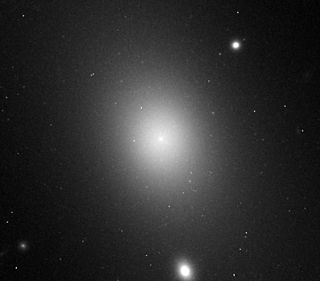
IC 1101 is a class S0 supergiant (cD) lenticular galaxy at the center of the Abell 2029 galaxy cluster. It has an isophotal diameter at about 123.65 to 169.61 kiloparsecs. It possesses a diffuse core which is the largest known core of any galaxy to date, and contains a supermassive black hole, one of the largest discovered. IC 1101 is located at 354.0 megaparsecs from Earth. It was discovered on 19 June 1790, by the British astronomer William Herschel.

Abell 1689 is a galaxy cluster in the constellation Virgo over 2.3 billion light-years away.

The Comet Galaxy, a spiral galaxy located 3.2 billion light-years from Earth, in the galaxy cluster Abell 2667, was found with the Hubble Space Telescope. This galaxy has slightly more mass than our Milky Way. It was detected on 2 March 2007.
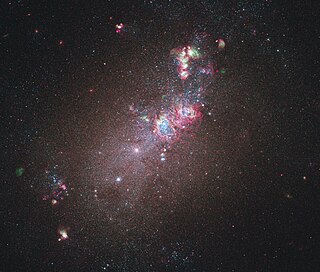
NGC 4214 is a dwarf barred irregular galaxy located around 10 million light-years away in the constellation Canes Venatici. It was discovered on 28 April 1785 by German-British astronomer William Herschel. NGC 4214 is a member of the M94 Group.
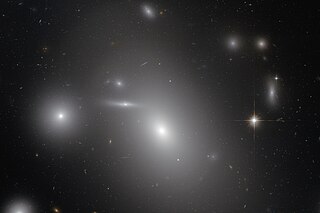
NGC 4889 is an E4 supergiant elliptical galaxy. It was discovered in 1785 by the British astronomer Frederick William Herschel I, who catalogued it as a bright, nebulous patch. The brightest galaxy within the northern Coma Cluster, it is located at a median distance of 94 million parsecs from Earth. At the core of the galaxy is a supermassive black hole that heats the intracluster medium through the action of friction from infalling gases and dust. The gamma ray bursts from the galaxy extend out to several million light years of the cluster.
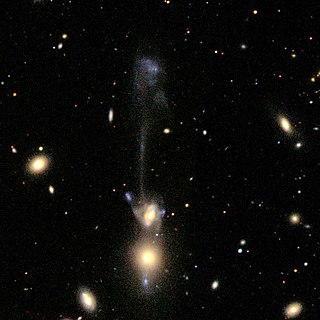
NGC 3561, also known as Arp 105, is a pair of interacting galaxies NGC 3561A and NGC 3561B within the galaxy cluster Abell 1185 in Ursa Major. Its common name is "the Guitar" and contains a small tidal dwarf galaxy known as Ambartsumian's Knot that is believed to be the remnant of the extensive tidal tail pulled out of one of the galaxies.
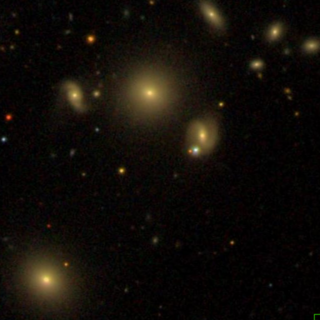
NGC 3552 is a lenticular galaxy in the constellation Ursa Major. It was discovered on April 11, 1785 by William Herschel. It is a member of the galaxy cluster Abell 1185.
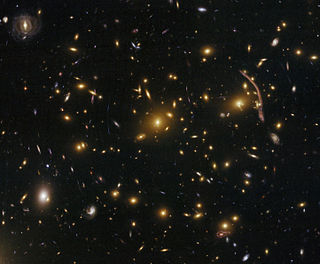
Abell 370 is a galaxy cluster located nearly 5 billion light-years away from the Earth, in the constellation Cetus. Its core is made up of several hundred galaxies. It was catalogued by George Abell, and is the most distant of the clusters he catalogued.

Abell 2744, nicknamed Pandora's Cluster, is a giant galaxy cluster resulting from the simultaneous pile-up of at least four separate, smaller galaxy clusters that took place over a span of 350 million years, and is located approximately 4 billion light years from Earth. The galaxies in the cluster make up less than five percent of its mass. The gas is so hot that it shines only in X-rays. Dark matter makes up around 75 percent of the cluster's mass.

ESO 444-46 is a class E4 supergiant elliptical galaxy; the dominant and brightest member of the Abell 3558 galaxy cluster around 195 megaparsecs away in the constellation Centaurus. It lies within the core of the massive Shapley Supercluster, one of the closest neighboring superclusters. It is one of the largest galaxies in the local universe, and possibly contains one of the most massive black holes known. The black hole's mass is very uncertain, with estimates ranging from as low as 501 million M☉, to as high as 77.6 billion M☉.

NGC 3558 is an elliptical or a lenticular galaxy located 440 million light-years away in the constellation Ursa Major. It was discovered by the astronomer Heinrich d'Arrest on April 15, 1866. It is a member of the galaxy cluster Abell 1185 and is classified as a LINER galaxy.

NGC 541 is a lenticular galaxy located in the constellation Cetus. It is located at a distance of about 230 million light years from Earth, which, given its apparent dimensions, means that NGC 541 is about 130,000 light years across. It was discovered by Heinrich d'Arrest on October 30, 1864. It is a member of the Abell 194 galaxy cluster and is included in the Atlas of Peculiar Galaxies in the category galaxies with nearby fragments. NGC 541 is a radio galaxy of Fanaroff–Riley class I, also known as 3C 40A.

NGC 545 is a lenticular galaxy located in the constellation Cetus. It is located at a distance of about 250 million light years from Earth, which, given its apparent dimensions, means that NGC 545 is about 180,000 light years across. It was discovered by William Herschel on October 1, 1785. It is a member of the Abell 194 galaxy cluster and is included along with NGC 547 in the Atlas of Peculiar Galaxies.

NGC 547 is an elliptical galaxy and radio galaxy located in the constellation Cetus. It is located at a distance of about 220 million light years from Earth, which, given its apparent dimensions, means that NGC 547 is about 120,000 light years across. It was discovered by William Herschel on October 1, 1785. It is a member of the Abell 194 galaxy cluster and is included along with NGC 547 in the Atlas of Peculiar Galaxies.

ESO 383-76 is an elongated, X-ray luminous supergiant elliptical galaxy, residing as the dominant, brightest cluster galaxy (BCG) of the Abell 3571 galaxy cluster, the sixth-brightest in the sky at X-ray wavelengths. It is located at the distance of 200.6 megaparsecs from Earth, and is possibly a member of the large Shapley Supercluster. With a diameter of about 540.89 kiloparsecs, it is one of the largest galaxies known. It also contains a supermassive black hole, one of the most massive known with mass estimates varying from 2 billion M☉ to 28 billion M☉.




















